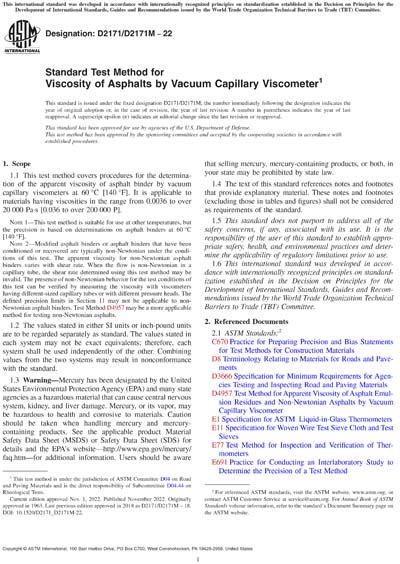Most recent
ASTM D2171/D2171M-22
Standard Test Method for Viscosity of Asphalts by Vacuum Capillary Viscometer
1.1This test method covers procedures for the determination of the apparent viscosity of asphalt binder by vacuum capillary viscometers at 60 °C [140 °F]. It is applicable to materials having viscosities in the range from 0.0036 to over 20 000 Pa·s [0.036 to over 200 000 P].
Note 1:This test method is suitable for use at other temperatures, but the precision is based on determinations on asphalt binders at 60 °C [140 °F].
Note 2:Modified asphalt binders or asphalt binders that have been conditioned or recovered are typically non-Newtonian under the conditions of this test. The apparent viscosity for non-Newtonian asphalt binders varies with shear rate. When the flow is non-Newtonian in a capillary tube, the shear rate determined using this test method may be invalid. The presence of non-Newtonian behavior for the test conditions of this test can be verified by measuring the viscosity with viscometers having different-sized capillary tubes or with different pressure heads. The defined precision limits in Section 11 may not be applicable to non-Newtonian asphalt binders. Test Method D4957 may be a more applicable method for testing non-Newtonian asphalts.
1.2The values stated in either SI units or inch-pound units are to be regarded separately as standard. The values stated in each system may not be exact equivalents; therefore, each system shall be used independently of the other. Combining values from the two systems may result in nonconformance with the standard.
1.3Warning - Mercury has been designated by the United States Environmental Protection Agency (EPA) and many state agencies as a hazardous material that can cause central nervous system, kidney, and liver damage. Mercury, or its vapor, may be hazardous to health and corrosive to materials. Caution should be taken when handling mercury and mercury-containing products. See the applicable product Material Safety Data Sheet (MSDS) or Safety Data Sheet (SDS) for details and the EPA's website - http://www.epa.gov/mercury/faq.htm - for additional information. Users should be aware that selling mercury, mercury-containing products, or both, in your state may be prohibited by state law.
1.4The text of this standard references notes and footnotes that provide explanatory material. These notes and footnotes (excluding those in tables and figures) shall not be considered as requirements of the standard.
1.5This standard does not purport to address all of the safety concerns, if any, associated with its use. It is the responsibility of the user of this standard to establish appropriate safety, health, and environmental practices and determine the applicability of regulatory limitations prior to use.
1.6This international standard was developed in accordance with internationally recognized principles on standardization established in the Decision on Principles for the Development of International Standards, Guides and Recommendations issued by the World Trade Organization Technical Barriers to Trade (TBT) Committee.
Content Provider
ASTM International [astm]






